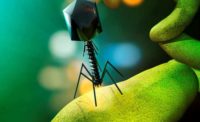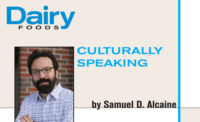Cultured dairy: Rethinking phage
Not all phage are problematic - you might actually want some to go viral in your facility

It seems like anything — your insightful comments, cat pictures, video of your coworker falling over — can be instantly shared, then spread from one smartphone, connected mind to the next, like a super-contagious flu. There rarely seems to be any rhyme or reason to their spread.
In the analog world of dairy, we’ve long had struggles with a less entertaining viral spread, that of the dreaded phage. Bacteriophage (their name literally means “eater of bacteria”) are viruses that infect and kill the bacteria we as cultured dairy producers so loving tend to. I’ve heard stories of seasonal winds, cursed tanks, and even maintenance guys walking by at the wrong time, and before you know it, the phage have gone viral, and all that’s left is a ruined vat.
I study phage, and sometimes it feels like whispering the name of “he who must not be named” when I find myself in a dairy facility. But phage are increasingly being summoned in the production halls of other foods. Turns out not all phage are the same, and in the future, you might actually want some to go viral in your facility.
Not without benefits
One of the beneficial things about phage is that they are very specific about their targets. Some infect only a specific Lactococcus strain and not a Lactobacillus, and vice versa. More important, there are phage out there that target only bacteria that cause us problems — for example, the pathogen Listeria or the spoiler Pseudomonas.
Traditional antimicrobials used for control have been broad spectrum, and in many cases impact the bacterial cultures we wanted to keep along with those we didn’t. With the right phage, companies can now seek and destroy only the bacteria that negatively impact the safety and quality of their products, leaving the others untouched.
Bacteria can develop resistance to phage, but the evolutionary game of cat and mouse between these two has been going on for millennia. There’s always new phage, and researchers are working hard to find them and develop new ways to create them so that phage remain effective tools to combat and control bacteria.
It doesn’t end there. Remember those addictive yet frustration-inducing claw machine games at the arcade? They always lost a grip on the toy at the last second!
Bacteria are pretty tough to pull out of foods, too, and many of the ways we try are not as effective as we would like. Turns out phage, using their tails, bind incredibly tightly to bacteria, so tightly that it is irreversible.
Researchers have been working with these phage tails and incorporating them onto tiny metal beads. It has allowed them to create a nano-magnetic version of that claw machine that actually works to yank Salmonella out so the lab can effectively test for contamination in a food.
I’ve been called a dreamer, but I like to think of phage as miniature robots that can be programmed with tweaks to their DNA to do my bidding as they float around the microbial world. For example, haven’t you always wanted a robot to help clean up your room?
Now there are commercially available phage that have been designed to produce what are essentially molecular “signal flares” when they come across Listeria in an environmental swab sample. This allows quality managers to respond in hours, rather than days, to address sanitation issues, clean up the production environment and ensure the safety of their dairy products. It’s not quite putting away your socks, but I’ll take it.
Homing missiles, microbial cranes, robotic guards — phage can be so much more than the apocalyptic end of our dairy culture. They can be used to build a cultural utopia. If you’ve found my phage excitement infective, share it with a tweet. Maybe we’ll go viral!
Looking for a reprint of this article?
From high-res PDFs to custom plaques, order your copy today!





